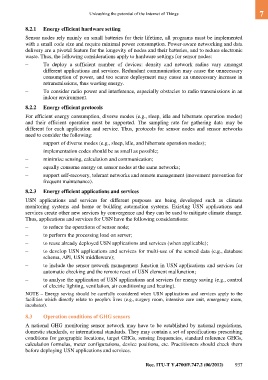Page 951 - Unleashing the potenti al of the Internet of Things
P. 951
Unleashing the potential of the Internet of Things 7
8.2.1 Energy efficient hardware setting
Sensor nodes rely mainly on small batteries for their lifetime, all programs must be implemented
with a small code size and require minimal power consumption. Power-aware networking and data
delivery are a pivotal feature for the longevity of nodes and their batteries, and to reduce electronic
waste. Thus, the following considerations apply to hardware settings for sensor nodes:
– To deploy a sufficient number of devices: density and network radius vary amongst
different applications and services. Redundant communication may cause the unnecessary
consumption of power, and too scarce deployment may cause an unnecessary increase in
retransmissions, thus wasting energy.
– To consider radio power and interference, especially obstacles to radio transmissions in an
indoor environment.
8.2.2 Energy efficient protocols
For efficient energy consumption, diverse modes (e.g., sleep, idle and hibernate operation modes)
and their efficient operation must be supported. The sampling rate for gathering data may be
different for each application and service. Thus, protocols for sensor nodes and sensor networks
need to consider the following:
– support of diverse modes (e.g., sleep, idle, and hibernate operation modes);
– implementation codes should be as small as possible;
– minimize sensing, calculation and communication;
– equally consume energy on sensor nodes at the same networks;
– support self-recovery, tolerant networks and remote management (movement prevention for
frequent maintenance).
8.2.3 Energy efficient applications and services
USN applications and services for different purposes are being developed such as climate
monitoring systems and home or building automation systems. Existing USN applications and
services create other new services by convergence and they can be used to mitigate climate change.
Thus, applications and services for USN have the following considerations:
– to reduce the operations of sensor node;
– to perform the processing load on server;
– to reuse already deployed USN applications and services (when applicable);
– to develop USN applications and services for multi-use of the sensed data (e.g., database
schema, API, USN middleware);
– to include the sensor network management function in USN applications and services for
automatic checking and the remote reset of USN element malfunction;
– to analyse the application of USN applications and services for energy saving (e.g., control
of electric lighting, ventilation, air conditioning and heating).
NOTE – Energy saving should be carefully considered when USN applications and services apply to the
facilities which directly relate to people's lives (e.g., surgery room, intensive care unit, emergency room,
incubator).
8.3 Operation conditions of GHG sensors
A national GHG monitoring sensor network may have to be established by national regulations,
domestic standards, or international standards. They may contain a set of specifications prescribing
conditions for geographic locations, target GHGs, sensing frequencies, standard reference GHGs,
calculation formulas, meter configurations, device positions, etc. Practitioners should check them
before deploying USN applications and services.
Rec. ITU-T Y.4700/F.747.2 (06/2012) 937

